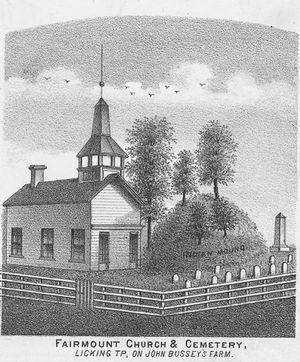Difference between revisions of "Fairmount Mound"
| Line 1: | Line 1: | ||
| − | Fairmount Mound is sited just north of the National Road (US-40) at Fairmount Church on a road of the same name. The large burial mound is in part attributed to the Hopewell cultural period and, like other Native-American mounds, it has become incorporated into the modern landscape as a sacred space. <ref> Pacheco, P. "The Legacy of the Licking River Basin Moundbuilders," Vanishing Heritage, 23-25. </ref> Sitting very close to the mound is Fairmount Presbyterian Church, and the area around the mound became a burial site for American settlers in the area in the mid-nineteenth century. This reuse of the sacred space has helped preserve this fifteen-foot high and eighty-foot wide, prehistoric structure. <ref> Woodward and Mcdonald, Indian Mounds of the Middle Ohio Valley, (2002), 185-186. </ref> The church was organized in 1834 by Rev. Jonathan Cable and built a building erected in 1835. <ref> Hill, N. History of Licking County, Ohio, (1881), 496 </ref> The same cannot be said for the numerous embankments and mounds in the surrounding area, which have been generally destroyed through human activity. <ref> Hill, N. History of Licking County, Ohio, (1881), 420. </ref> | + | Fairmount Mound is sited just north of the National Road (US-40) at Fairmount Church on a road of the same name. The large burial mound is in part attributed to the Hopewell cultural period and, like other Native-American mounds, it has become incorporated into the modern landscape as a sacred space. <ref> Pacheco, P. "The Legacy of the Licking River Basin Moundbuilders," Vanishing Heritage, (1992), 23-25. </ref> Sitting very close to the mound is Fairmount Presbyterian Church, and the area around the mound became a burial site for American settlers in the area in the mid-nineteenth century. This reuse of the sacred space has helped preserve this fifteen-foot high and eighty-foot wide, prehistoric structure. <ref> Woodward and Mcdonald, Indian Mounds of the Middle Ohio Valley, (2002), 185-186. </ref> The church was organized in 1834 by Rev. Jonathan Cable and built a building erected in 1835. <ref> Hill, N. History of Licking County, Ohio, (1881), 496 </ref> The same cannot be said for the numerous embankments and mounds in the surrounding area, which have been generally destroyed through human activity. <ref> Hill, N. History of Licking County, Ohio, (1881), 420. </ref> |
| + | [[File:Fairmount mound and church from 1875 atlas.jpg|thumb|Sketch of Fairmount Mound and Church from 1875 Atlas of Licking County]] | ||
| + | |||
| + | |||
| + | [[File:FFile:Fairmount Mound and cemetery in 1904.jpg|thumb|Sketch of Fairmount Mound and Church as they appeared in a photograph from 1904]] | ||
J.G. | J.G. | ||
==References== | ==References== | ||
Revision as of 09:15, 8 December 2020
Fairmount Mound is sited just north of the National Road (US-40) at Fairmount Church on a road of the same name. The large burial mound is in part attributed to the Hopewell cultural period and, like other Native-American mounds, it has become incorporated into the modern landscape as a sacred space. [1] Sitting very close to the mound is Fairmount Presbyterian Church, and the area around the mound became a burial site for American settlers in the area in the mid-nineteenth century. This reuse of the sacred space has helped preserve this fifteen-foot high and eighty-foot wide, prehistoric structure. [2] The church was organized in 1834 by Rev. Jonathan Cable and built a building erected in 1835. [3] The same cannot be said for the numerous embankments and mounds in the surrounding area, which have been generally destroyed through human activity. [4]
J.G.
